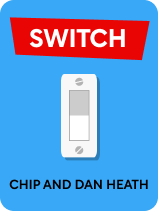

This article is an excerpt from the Shortform book guide to "Switch" by Chip and Dan Heath. Shortform has the world's best summaries and analyses of books you should be reading.
Like this article? Sign up for a free trial here .
What is choice overload? How does it impact our ability to change?
Choice overload happens when people are overwhelmed with options. It can lead to decision paralysis—when we end up either doing nothing or doing the same thing every time. Ultimately, it makes change difficult. Too much ambiguity, just like too many options, can thwart change efforts.
Keep reading to learn how to overcome choice overload and ambiguity in order to bring about change.
Avoiding Choice Overload and Ambiguity
Humans are predisposed to “decision paralysis” when experiencing choice overload. That is, when you’re presented with too many options you tend to default to whatever feels easiest or most familiar, or you don’t do anything at all.
- For example, if you were asked to choose between 15 different brands of peanut butter, you’d likely become overwhelmed and end up choosing the same brand you always buy.
When choice overload results in decision paralysis, you default to familiar options because doing so saves energy. When you’re functioning on autopilot—that is, making familiar choices—you’re not expending any energy on decision-making. Change disrupts your autopilot, forcing you to consider options, make deliberate decisions, and supervise your behaviors. This quickly depletes your rational thinking power, allowing your emotional side to take over control. And of course, your emotional side will always choose the instant gratification of the status quo instead of the difficult work of change.
Decision paralysis doesn’t come only from choice overload—it also stems from getting trapped by ambiguity. Unclear options trigger overanalysis and questions, and we can’t move forward until we feel we have an answer to those questions.
- Too many options (choice overload) looks like being told, “It’s a healthy choice to drink a smoothie instead of eating a bagel,” and then having 30 different smoothie flavors to choose from.
- Too much ambiguity looks like being told, “Eat a healthier breakfast.” This prompts numerous questions: What is the benchmark for “healthy”? Are smoothies healthy or full of sugar? Would fruit or oatmeal be a healthier choice?
Avoiding Decision Paralysis
You can circumvent choice overload and ambiguity around a change by setting specific actions as behavioral guidelines. The specificity of these guidelines pushes you toward your goals while cutting out the need to deliberate about “good” behavior—conserving your rational energy. You don’t need to create guidelines for every imaginable scenario. That would be close to impossible. Instead, focus on several small, critical behaviors.
For example, if you’re trying to eat healthier breakfasts, you can’t predict what foods will be available to you every morning. Instead, you might put together four critical guidelines:
- Never eat anything that’s covered in whipped cream.
- Don’t drink Diet Coke before noon.
- Every breakfast must contain at least one vegetable or fruit.
- Indulge in a carb-heavy breakfast such as pancakes only once per week.
Over time, these guidelines become more instinctive than unfamiliar—the status quo that your autopilot defaults to. This creates sustainable change because the desired behaviors will no longer require your rational side’s concentrated effort or self-supervision.
Erasing Ambiguity for Others
Erasing ambiguity is important when trying to get others to change their behaviors, because what you consider the “right” choices aren’t always the most obvious choices to others. They, like you, have a rational side that will overanalyze their options, seek solutions on the same scale as the problem, and get caught up in useless details. When presenting others with a proposed change, make the new way of doing things crystal clear—don’t assume that they’ll figure out how to accomplish it on their own.
Example: Saving Miner County
Students in Miner County, South Dakota—a shrinking town with few jobs and South Dakota’s highest rate of youth emigration—wanted to prevent their county from disappearing from the map. They set a huge, ambiguous goal: Save Miner County.
Locals supported the idea but had no idea what changes they needed to make to accomplish it. Should they focus on sparking interest in the county’s history? Find a way to leverage their location? Turn their efforts toward diversifying their demographics? The complexity of the problem and the range of possible solutions (choice overload) sparked decision paralysis.
The students discovered that most Miner County locals were doing their shopping in towns far outside the county, but if they spent just 10% more of their disposable income within the county, they’d add $7 million to the local economy. They offered a straightforward solution to a complex problem and clearly scripted a critical behavior: Spend more money in Miner County.
Within a year, the economy grew by $15.6 million, and the taxes generated by local spending supported the community’s schools, public spaces, and businesses. Over the following years, as money went back into the community and revitalized it, the county reestablished itself on the map with new industries like organic beef production and wind turbine repair.
Once you understand choice overload and acknowledge ambiguity, you can avoid decision paralysis and help bring about real change.

———End of Preview———
Like what you just read? Read the rest of the world's best book summary and analysis of Chip and Dan Heath's "Switch" at Shortform .
Here's what you'll find in our full Switch summary :
- Why some changes succeed while others fail
- Actionable advice for creating changes that not only succeed but stick
- The three essential elements for successful change






